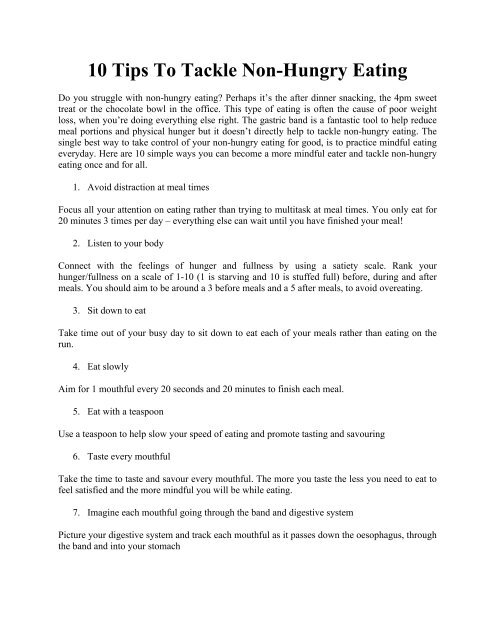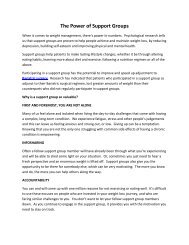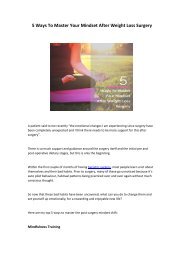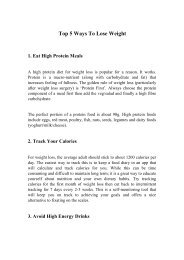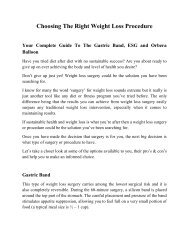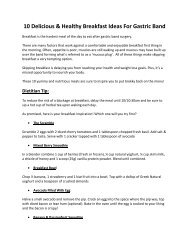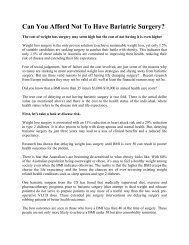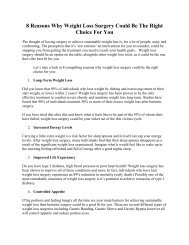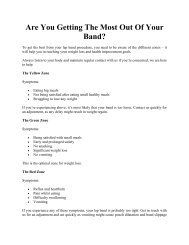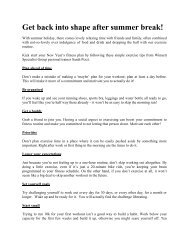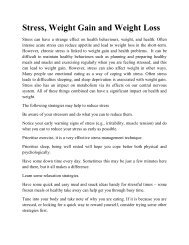10 Tips To Tackle Non-Hungry Eating
If you are looking for the best way to take control of your non-hungry eating for good, take a look at the article and get 10 useful tips to tackle non-hungry eating. For more detail, visit http://winnettspecialistgroup.com.au/10-tips-to-tackle-non-hungry-eating/
If you are looking for the best way to take control of your non-hungry eating for good, take a look at the article and get 10 useful tips to tackle non-hungry eating. For more detail, visit http://winnettspecialistgroup.com.au/10-tips-to-tackle-non-hungry-eating/
You also want an ePaper? Increase the reach of your titles
YUMPU automatically turns print PDFs into web optimized ePapers that Google loves.
<strong>10</strong> <strong>Tips</strong> <strong>To</strong> <strong>Tackle</strong> <strong>Non</strong>-<strong>Hungry</strong> <strong>Eating</strong><br />
Do you struggle with non-hungry eating? Perhaps it’s the after dinner snacking, the 4pm sweet<br />
treat or the chocolate bowl in the office. This type of eating is often the cause of poor weight<br />
loss, when you’re doing everything else right. The gastric band is a fantastic tool to help reduce<br />
meal portions and physical hunger but it doesn’t directly help to tackle non-hungry eating. The<br />
single best way to take control of your non-hungry eating for good, is to practice mindful eating<br />
everyday. Here are <strong>10</strong> simple ways you can become a more mindful eater and tackle non-hungry<br />
eating once and for all.<br />
1. Avoid distraction at meal times<br />
Focus all your attention on eating rather than trying to multitask at meal times. You only eat for<br />
20 minutes 3 times per day – everything else can wait until you have finished your meal!<br />
2. Listen to your body<br />
Connect with the feelings of hunger and fullness by using a satiety scale. Rank your<br />
hunger/fullness on a scale of 1-<strong>10</strong> (1 is starving and <strong>10</strong> is stuffed full) before, during and after<br />
meals. You should aim to be around a 3 before meals and a 5 after meals, to avoid overeating.<br />
3. Sit down to eat<br />
Take time out of your busy day to sit down to eat each of your meals rather than eating on the<br />
run.<br />
4. Eat slowly<br />
Aim for 1 mouthful every 20 seconds and 20 minutes to finish each meal.<br />
5. Eat with a teaspoon<br />
Use a teaspoon to help slow your speed of eating and promote tasting and savouring<br />
6. Taste every mouthful<br />
Take the time to taste and savour every mouthful. The more you taste the less you need to eat to<br />
feel satisfied and the more mindful you will be while eating.<br />
7. Imagine each mouthful going through the band and digestive system<br />
Picture your digestive system and track each mouthful as it passes down the oesophagus, through<br />
the band and into your stomach
8. Be thankful<br />
Acknowledge the easy access we have to food in this country and how lucky we are to never be<br />
forced to go hungry. It is helpful to never take for granted the availability of food in Australia.<br />
9. Take time to think about how the food you are eating came to you<br />
Think about the number of people and processes the product has passed by/through to end up in<br />
your cupboard or fridge. For example with milk, acknowledge the cow, the farmer, the<br />
pasteurisation and packaging as well as distribution to the supermarkets via transport systems. As<br />
you can imagine, a lot of work goes into getting produce onto the supermarket shelves everyday.<br />
<strong>10</strong>. Practice self-monitoring<br />
A mindful eating food diary can be a helpful tool to ensure you are eating mindfully everyday as<br />
you can track and log your progress at each meal each day.<br />
http://winnettspecialistgroup.com.au/


